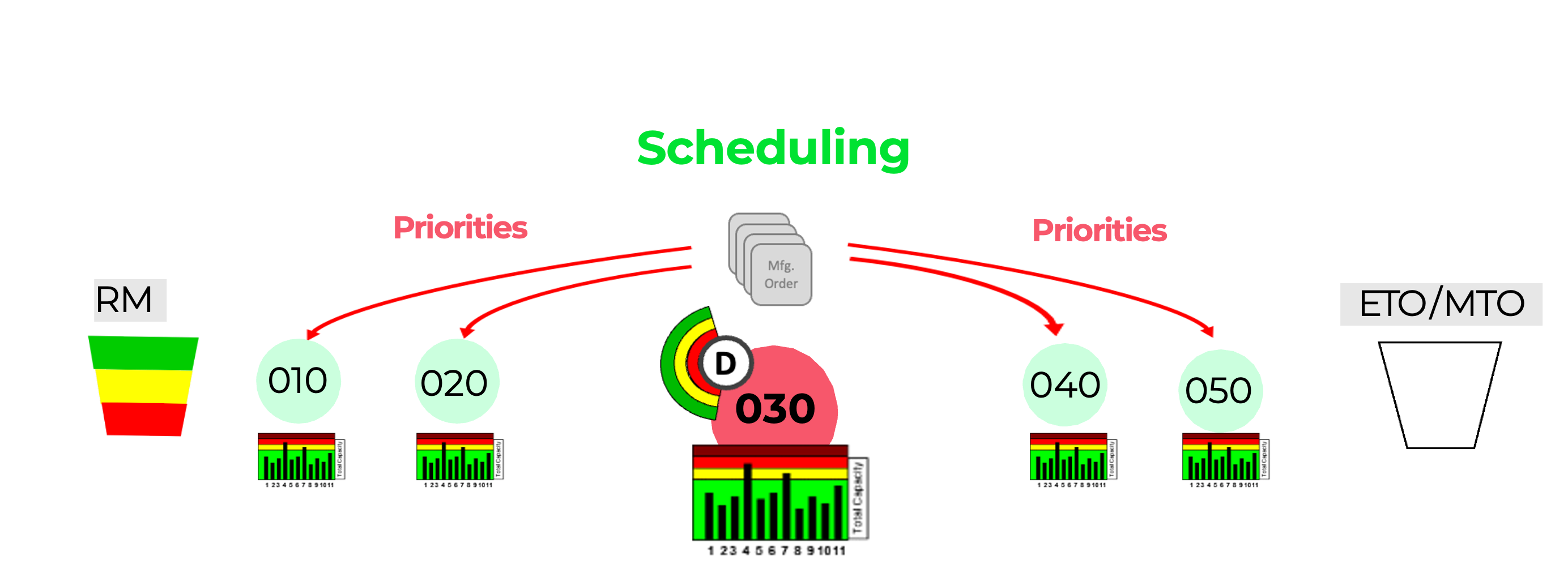Scheduling & Execution
Inside your factory, efficiency depends on flow, not just optimized demand forecasts. b2wise anchors your schedule to actual customer demand and real-world constraints, protecting key resources while synchronizing everything else around them. The goal is simple: fulfil the customer order.
It's about maximizing the flow, not just the optimizing work.
It's about maximizing the flow, not just the optimizing work.

Scheduling must always be about Flow
Scheduling & Execution is the critical shop floor process that ensures your work orders are released efficiently onto the shop floor.
By leveraging your routings and Theory of Constraints principles, b2wise focuses on your bottleneck resources to drive optimal work center utilization and maximize material flow through your operations.
Speak to an ExpertBy leveraging your routings and Theory of Constraints principles, b2wise focuses on your bottleneck resources to drive optimal work center utilization and maximize material flow through your operations.

DDMRP and Scheduling form the backbone of a Demand-Driven Operating Model (DDOM).

Over the past four years, we have improved our inventory levels by more than 20%, reduced the number of stockouts by over 40%, and also improved our planning time.
Ignacio Elizazu, Supply Chain Director -
How does the b2wise Scheduling & Execution differ from traditional methods?
Flow-First Scheduling
Maximizes flow and fill rate, not due dates or forecasts.
Alert-Driven Execution
Real-time response to demand changes. No frozen schedules.
Built-In Constraint Awareness
Plans around constraints, not around ideal capacity.
Throughput Focus with DrumBufferRope
Real-demand priorities eliminate guesswork and sharpen focus.
Simplicity as a Strategy
Lean, fast to implement, and avoids complexity.
The 5 ways b2wise enables you to set up your Schedule
Thank you! Your submission has been received!
Oops! Something went wrong while submitting the form.

To build your Schedule: You need to define how long it takes to manufacture each part at every operation or work centre. This is essential to calculate accurate capacity and lead time across your production flow.
How b2wise helps: b2wise uses the Planned Cycle Number (PCN) from your routing file or a manually entered production rate per part per work centre to automatically calculate the time needed to complete each job at each work station of the process.

To build your Schedule: You must define which days your operations are available and the number of shifts that run on each day. This gives structure to your planning window.
How b2wise helps: b2wise allows you to import or manually configure your calendar at daily or weekly intervals. If you set it up daily, it automatically rolls up into weekly summaries, giving you both granular control and big-picture visibility.
How b2wise helps: b2wise allows you to import or manually configure your calendar at daily or weekly intervals. If you set it up daily, it automatically rolls up into weekly summaries, giving you both granular control and big-picture visibility.

To build your Schedule: You need to define your drums—critical control points in your factory that dictate flow and determine the pace of execution.
How b2wise helps: b2wise shows you the real load on each work center based on actual demand—not forecasts—so you can accurately identify bottlenecks and position your drums for maximum throughput.
How b2wise helps: b2wise shows you the real load on each work center based on actual demand—not forecasts—so you can accurately identify bottlenecks and position your drums for maximum throughput.

To build your Schedule: You must establish a capacity buffer at each workstation that alerts you when your demand exceeds the available resources. This prevents overloading and helps you plan realistically.
How b2wise helps: b2wise gives you both a finite capacity view (in days) and a projected capacity (RCCP) view (in weeks). Gantt charts help you visualise order sequences and the sequence of prioritisation. If orders are transferred between production lines, all linked orders are recalculated automatically rescheduled.
How b2wise helps: b2wise gives you both a finite capacity view (in days) and a projected capacity (RCCP) view (in weeks). Gantt charts help you visualise order sequences and the sequence of prioritisation. If orders are transferred between production lines, all linked orders are recalculated automatically rescheduled.

To build your Schedule: You need to balance the load across all available production lines to avoid overloading one while others sit idle.Scheduling requires the scheduler to optimize the load across production lines.
How b2wise helps: b2wise allows you to change the assigned production line for an order either manually or through AI Agents. If one line is over capacity and another is free, orders are automatically switched to keep production flowing efficiently.
How b2wise helps: b2wise allows you to change the assigned production line for an order either manually or through AI Agents. If one line is over capacity and another is free, orders are automatically switched to keep production flowing efficiently.
Ready to see b2wise in action?



